Production and Characterization of Nanostructured Powders of Nd2Fe14B and Fe90Al10 by Mechanical Alloying
Abstract
:1. Introduction
2. Results
2.1. Fe90Al10 System
2.2. Nd2Fe14B System
2.3. Nd2Fe14B/Fe90Al10 Nanocomposite System
3. Experimental Process
4. Conclusions
Author Contributions
Funding
Institutional Review Board Statement
Informed Consent Statement
Data Availability Statement
Acknowledgments
Conflicts of Interest
References
- Durán Perdomo, J.F.; Pérez Alcázar, G.A.; Colorado, H.D.; Tabares, J.A.; Zamora, L.E.; Garitaonandia, J.J.S. Systematic Study of the Dependence of Magnetic and Structural Properties of Nd2Fe14B Powders on the Average Particle Size. J. Rare Earths 2020, 38, 961–968. [Google Scholar] [CrossRef]
- Ngo, H.M.; Lee, G.; Haider, S.K.; Pal, U.; Hawari, T.; Kim, K.M.; Kim, J.; Kwon, H.-W.; Kang, Y.S. Chemical Synthesis of Nd2Fe14B/Fe–Co Nanocomposite with High Magnetic Energy Product. RSC Adv. 2021, 11, 32376–32382. [Google Scholar] [CrossRef] [PubMed]
- Huang, G.; Lou, L.; Song, W.; Li, M.; Hou, F.; Li, X. Microstructure and Magnetic Properties of (SmCo+FeCo)/NdFeB Multicomponent Nanocomposite Magnets Fabricated by HPTC with Change in Heating Temperature and Composition. J. Rare Earths 2020, 38, 742–748. [Google Scholar] [CrossRef]
- Trujillo Hernández, J.S.; Tabares, J.A.; Pérez Alcázar, G.A. Comparative Magnetic and Structural Properties Study of Micro- and Nanopowders of Nd2Fe14B Doped with Ni. J. Supercond. Nov. Magn. 2017, 30, 3423–3430. [Google Scholar] [CrossRef]
- Cui, W.B.; Takahashi, Y.K.; Hono, K. Microstructure Optimization to Achieve High Coercivity in Anisotropic Nd–Fe–B Thin Films. Acta Mater. 2011, 59, 7768–7775. [Google Scholar] [CrossRef]
- Žák, T.; Talijan, N.; Čosović, V.; Grujić, A. Structure and Phases of Low-Neodymium NdFeB Permanent Magnets. Czechoslov. J. Phys. 2006, 56, E45–E50. [Google Scholar] [CrossRef]
- Kustas, A.B.; Susan, D.F.; Monson, T. Emerging Opportunities in Manufacturing Bulk Soft-Magnetic Alloys for Energy Applications: A Review. JOM 2022, 74, 1306–1328. [Google Scholar] [CrossRef]
- Kneller, E.F.; Hawig, R. The Exchange-Spring Magnet: A New Material Principle for Permanent Magnets. IEEE Trans. Magn. 1991, 27, 3560–3588. [Google Scholar] [CrossRef]
- Hadjipanayis, G.C.; Withanawasam, L.; Krause, R.F. Nanocomposite R/Sub 2/Fe/Sub 14/B/α-Fe Permanent Magnets. IEEE Trans. Magn. 1995, 31, 3596–3601. [Google Scholar] [CrossRef]
- Su, K.P.; Liu, Z.W.; Zeng, D.C.; Huo, D.X.; Li, L.W.; Zhang, G.Q. Structure and Size-Dependent Properties of NdFeB Nanoparticles and Textured Nano-Flakes Prepared from Nanocrystalline Ribbons. J. Phys. D Appl. Phys. 2013, 46, 245003. [Google Scholar] [CrossRef]
- Hou, P.; Ge, B.; Tao, D.; Pan, B.; Wang, Y. Rotor Strength Analysis of FeCo-Based Permanent Magnet High Speed Motor. Machines 2022, 10, 462. [Google Scholar] [CrossRef]
- Nouri, A.; Wen, C. Surfactants in Mechanical Alloying/Milling: A Catch-22 Situation. Crit. Rev. Solid State Mater. Sci. 2014, 39, 81–108. [Google Scholar] [CrossRef]
- Bustos Rodríguez, H.; Oyola Lozano, D.; Rojas Martínez, Y.A.; Trujillo Hernández, J.S.; Perez Alcazar, G.A. Evidence of Dipolar Magnetic Interaction in Melted Fe50Al50 Samples. J. Supercond. Nov. Magn. 2016, 29, 1357–1362. [Google Scholar] [CrossRef]
- Zamora, L.E.; Pérez Alcázar, G.A.; González, C.; Greneche, J.M.; Aguirre, W.R.; Bohórquez, A.; Baggio Saitovich, E.M.; Sánchez, D. Characterization of Magnetic Phases in the FexMn0.65−xAl0.35 Disordered Alloys. J. Magn. Magn. Mater. 2006, 301, 495–502. [Google Scholar] [CrossRef]
- González, C.; Alcázar, G.A.P.; Zamora, L.E.; Tabares, J.A.; Greneche, J.-M. Magnetic Properties of the FexMn0.600-XAl0.400, 0.200 ≤ x ≤ 0.600, Disordered Alloy Series. J. Phys. Condens. Matter 2002, 14, 320. [Google Scholar] [CrossRef]
- Kobayashi, T.; Yamasaki, M.; Hamano, M. Mössbauer Study on Intergranular Phases in the Bcc-Fe/NdFeB Nanocomposite Alloys. J. Appl. Phys. 2000, 87, 6579–6581. [Google Scholar] [CrossRef]
- Budzyński, M.; Constantin, V.C.; Popescu, A.-M.J.; Surowiec, Z.; Tkachenka, T.M.; Yanushkevich, K.I. Mössbauer Study of Treated Nd2Fe14B. Nukleonika 2015, 60, 7–10. [Google Scholar] [CrossRef] [Green Version]
- Suryanarayana, C. Mechanical Alloying: A Critical Review. Mater. Res. Lett. 2022, 10, 619–647. [Google Scholar] [CrossRef]
- Toby, B.H.; von Dreele, R.B. GSAS-II: The genesis of a modern open-source all purpose crystallography software package. J. Appl. Cryst. 2013, 46, 544–549. [Google Scholar] [CrossRef]
- Varret, F.; University of Le Mans, Le Mans, France; Greneche, J.-M.; University of Le Mans, Le Mans, France. Unpublished work. 1994.
- Chakka, V.M.; Altuncevahir, B.; Jin, Z.Q.; Li, Y.; Liu, J.P. Magnetic Nanoparticles Produced by Surfactant-Assisted Ball Milling. J. Appl. Phys. 2006, 99, 08E912. [Google Scholar] [CrossRef]

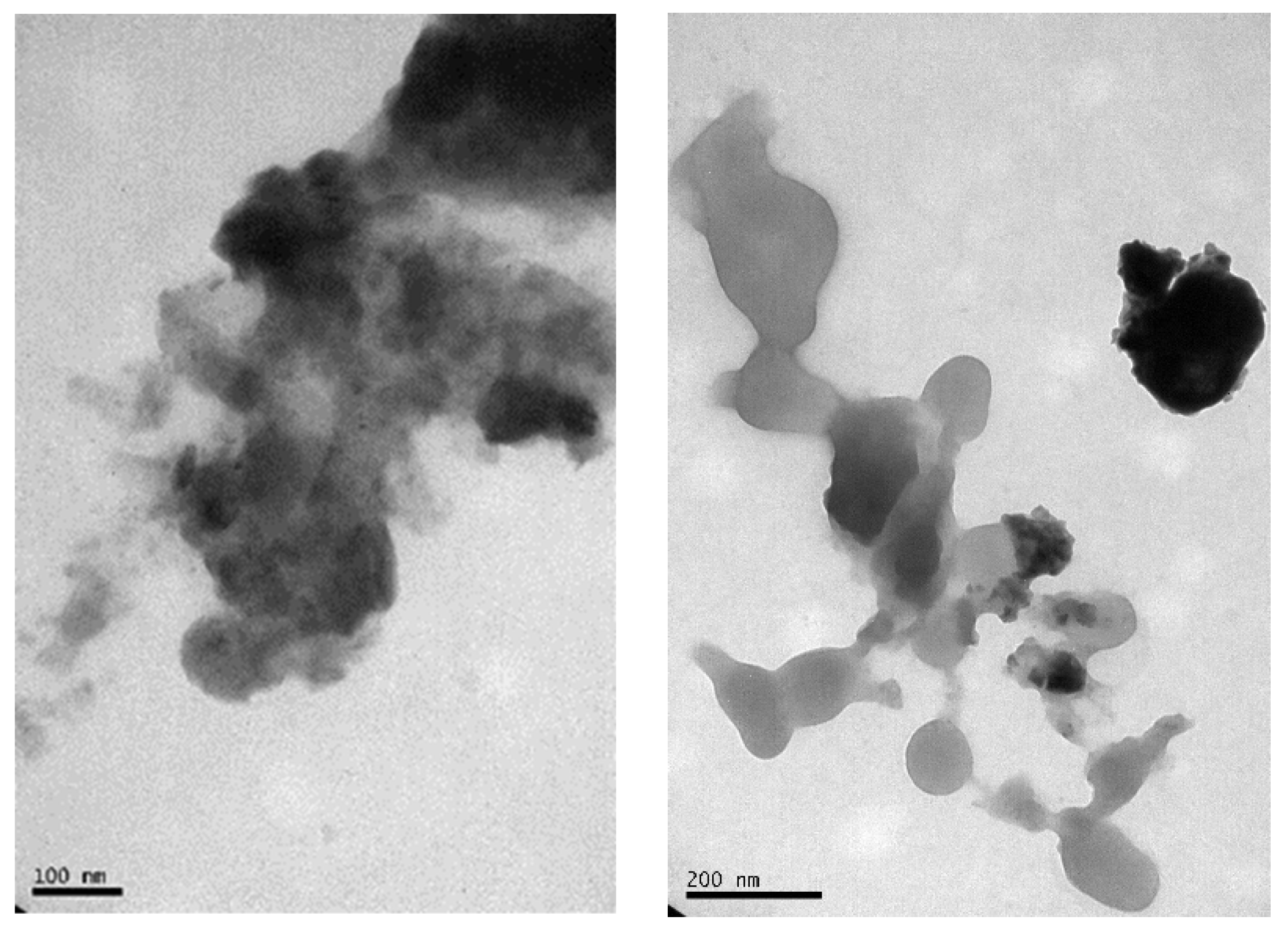
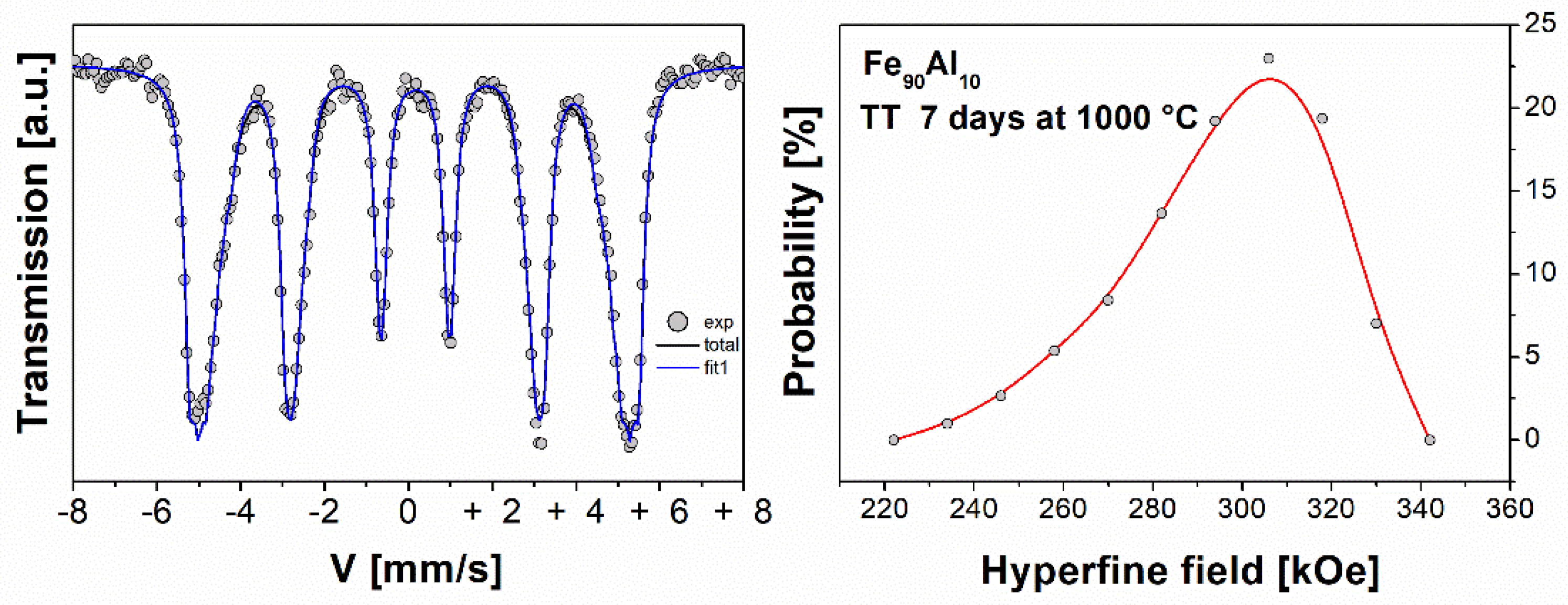
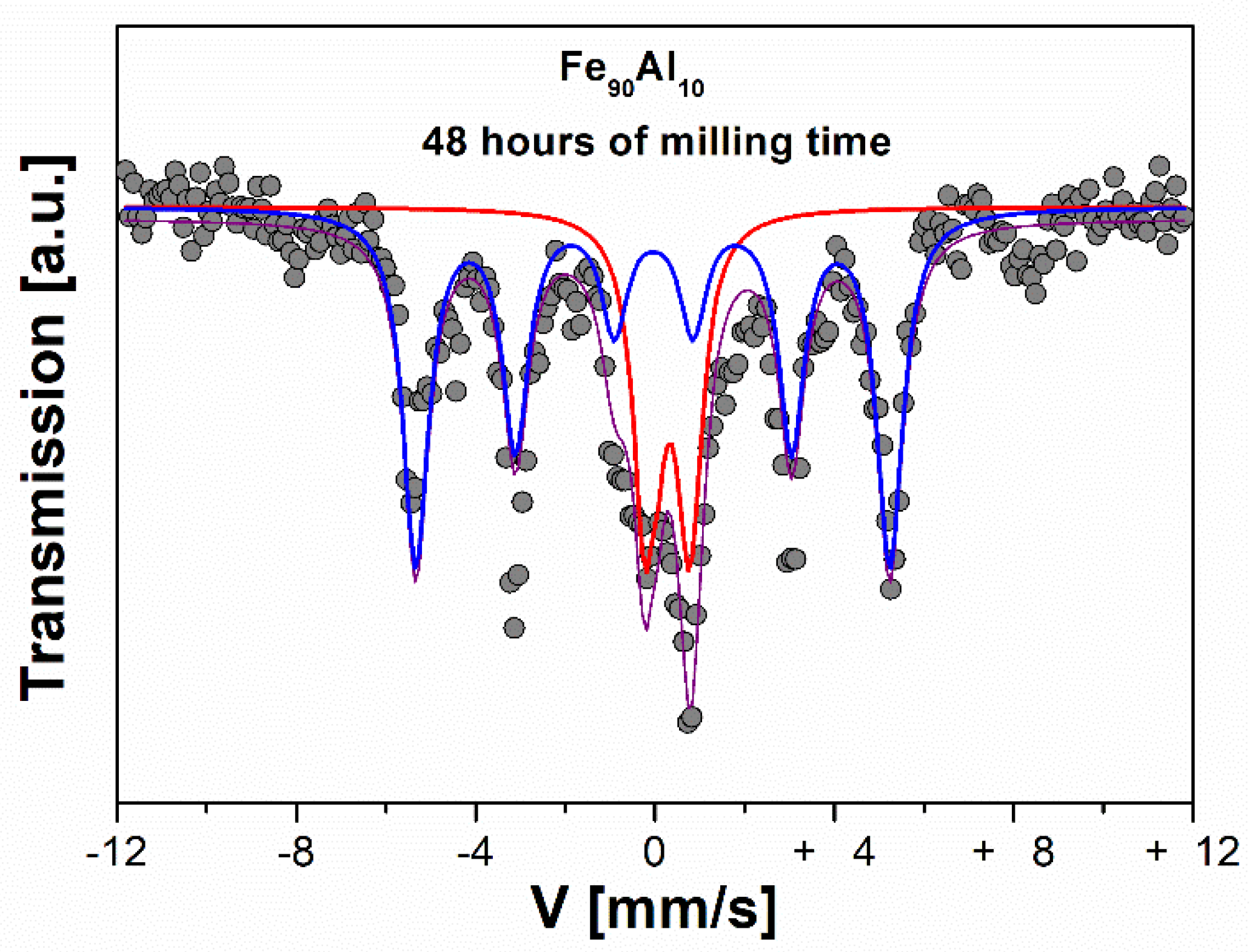



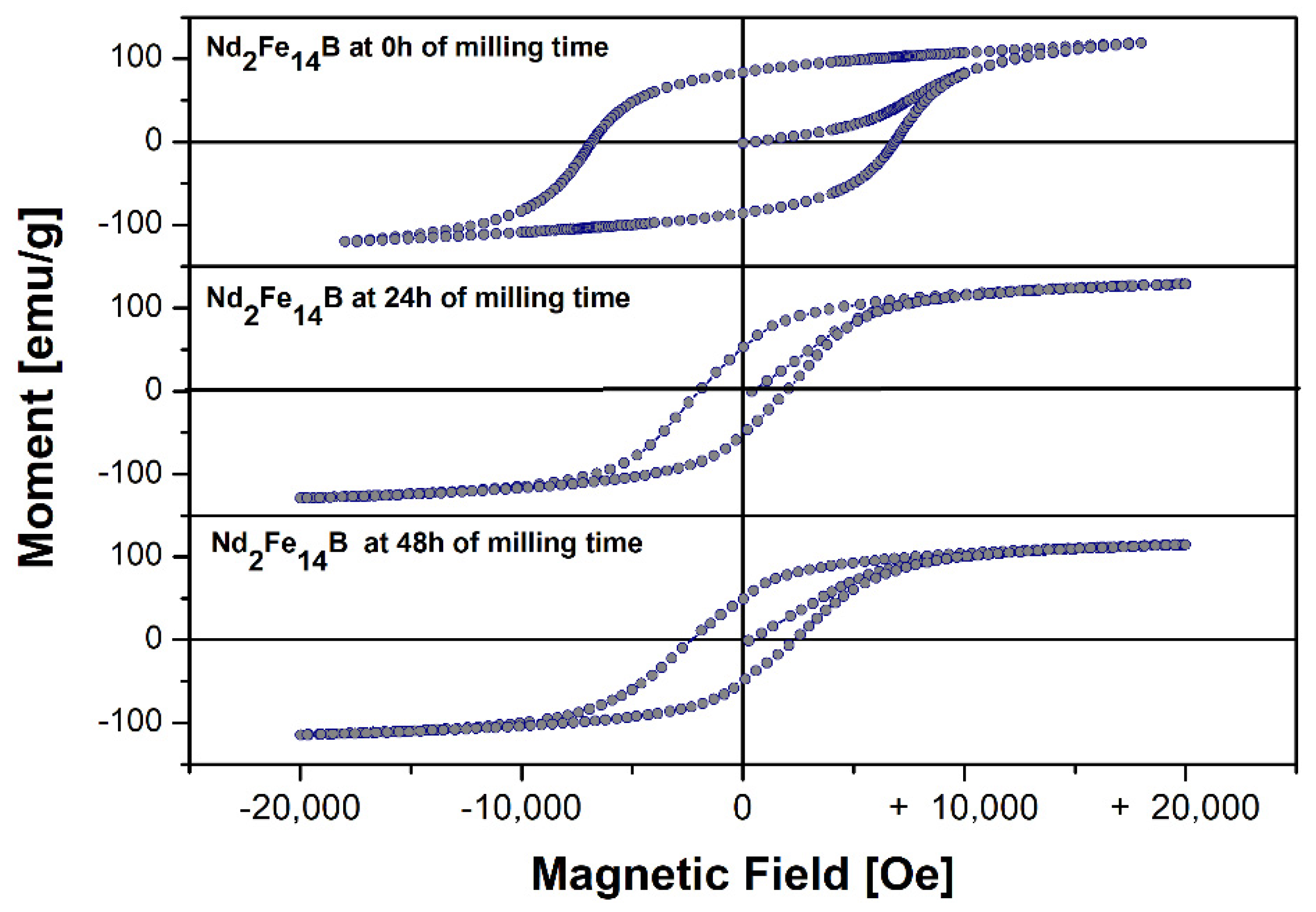
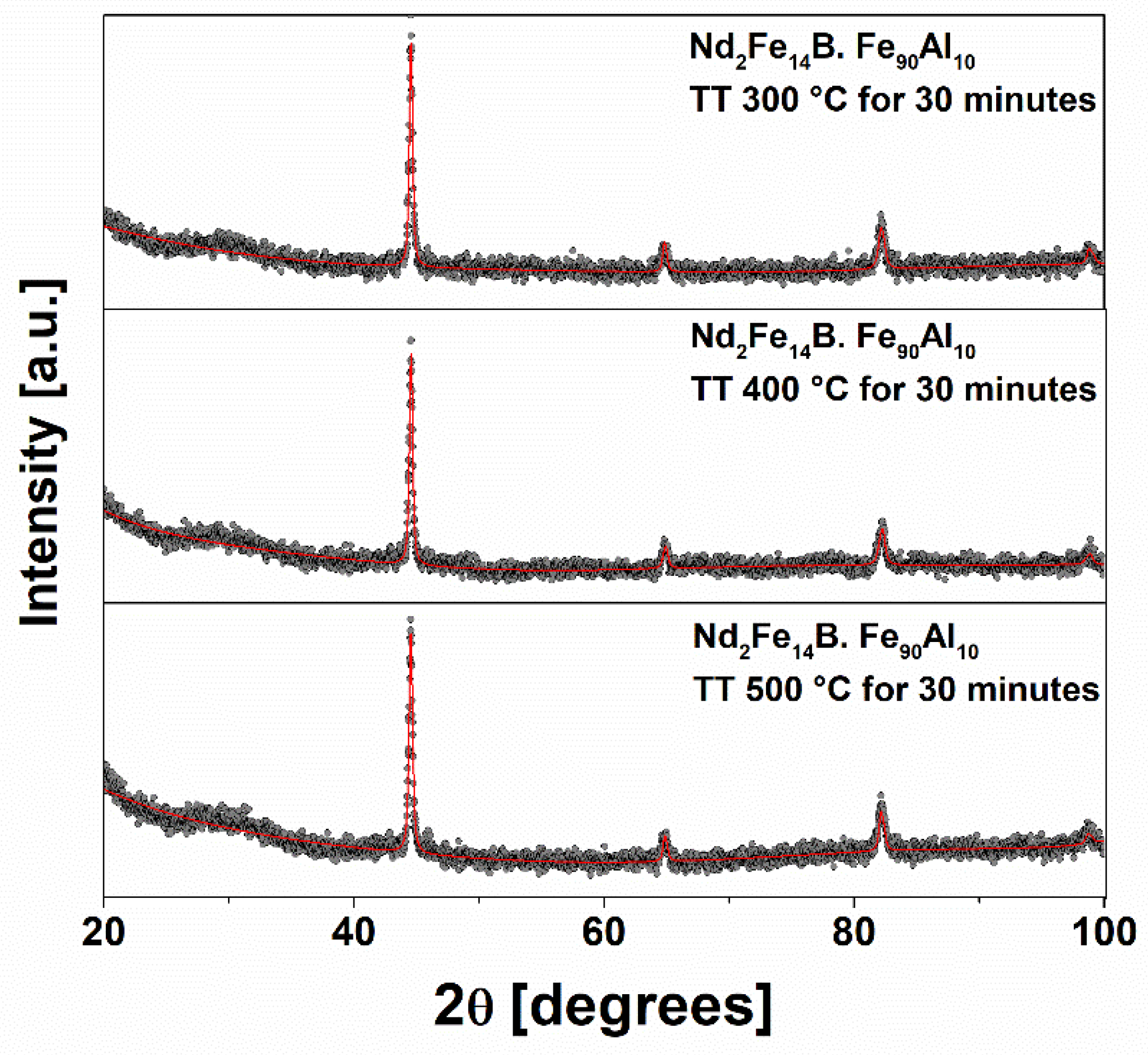
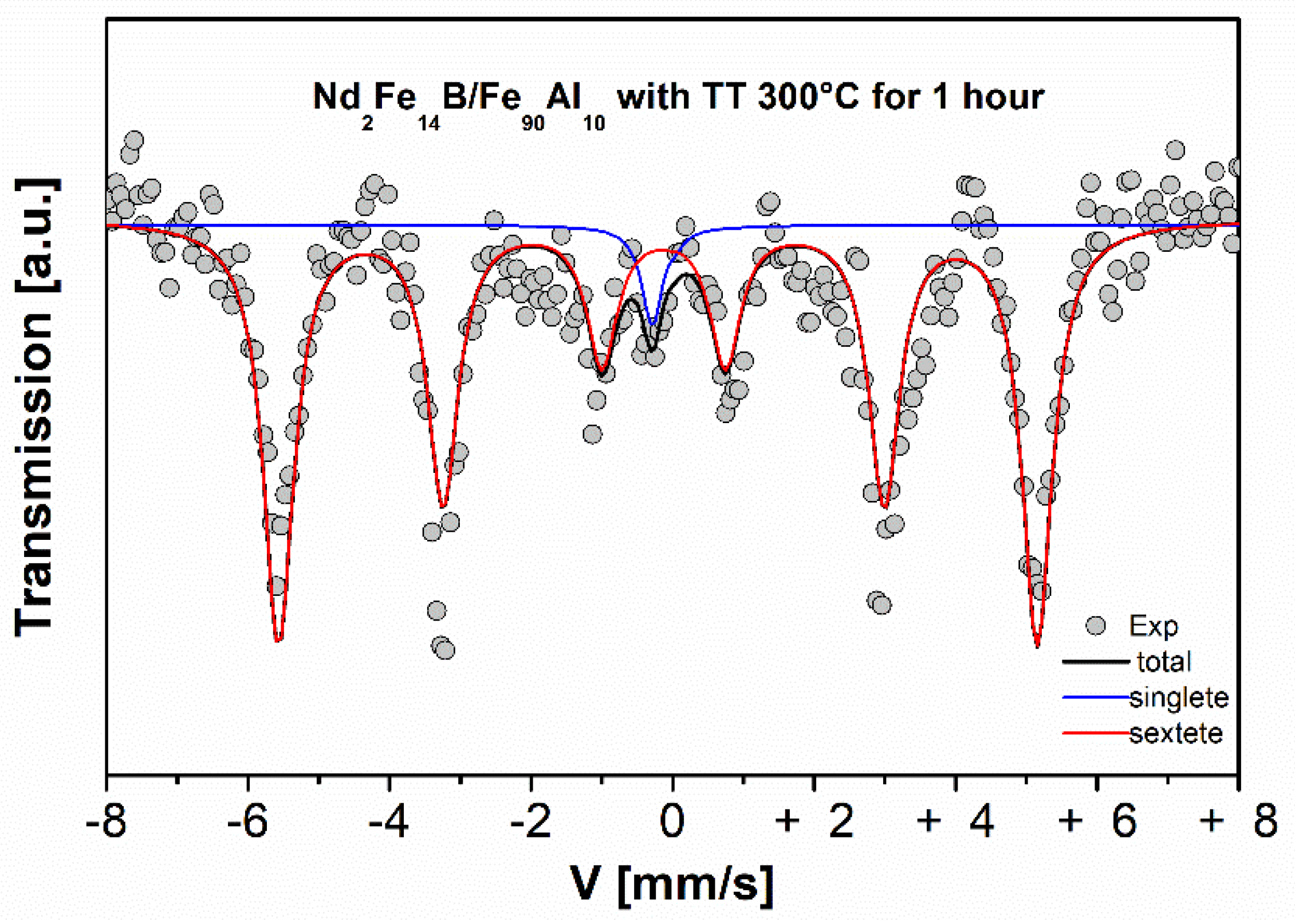
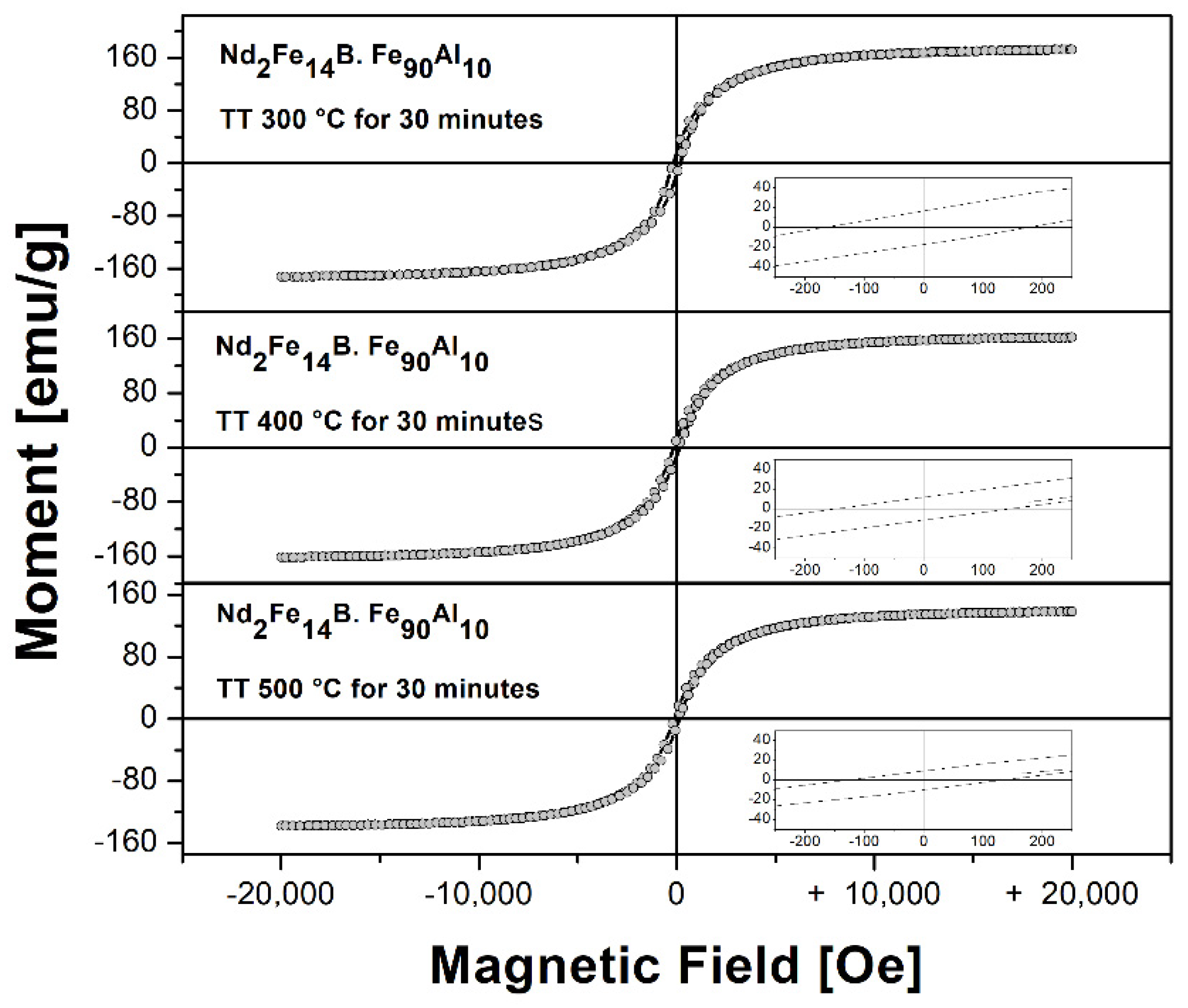
| Time | Density (g/cm3) ±0.04 | Volume (Å3) ±0.04 | a (Å) ±0.04 | Φper (nm) ±0.5 | Φpar (nm) ±0.5 |
|---|---|---|---|---|---|
| 0 h | 6.96 | 24.041 | 2.88 | 28.8 | 14.4 |
| 24 h | 6.99 | 23.937 | 2.88 | 21.7 | 18.1 |
| 48 h | 6.97 | 23.990 | 2.88 | 24.8 | 12.4 |
| Time | Component | δ (mm/s) ±0.005 | Г (mm/s) ±0.005 | Qs (mm/s) ±0.005 | HF (kOe) ±0.4 | Spectral Area % |
|---|---|---|---|---|---|---|
| 0 h | HMDF | 0.033 | −0.026 | 318.2 | ||
| 48 h | HMDF Doublet | 0.038 0.383 | 0.535 | 0.323 0.888 | 200.1 | 62.5 37.5 |
| Milling Time | Hc (Oe) ±0.4 | Mr (emu/g) ±0.4 | Ms (emu/g) ±0.4 |
|---|---|---|---|
| 0 h | 67.5 | 6.8 | 225.2 |
| 24 h | 33.3 | 2.3 | 173.7 |
| 48 h | 26.6 | 1.7 | 137.9 |
| Milling Time | Density (g/cm3) ±0.04 | Volume (Å3) ±0.04 | a (Å) ±0.04 | c (Å) ±0.04 | Φper (nm) ±0.5 | Φpar (nm) ±0.5 |
|---|---|---|---|---|---|---|
| 0 h | 7.58 | 947.26 | 8.80 | 12.20 | 54.7 | 34.4 |
| 24 h | 8.25 | 931.63 | 8.75 | 12.14 | 8.0 | 15.2 |
| 48 h | 9.09 | 899.08 | 8.63 | 12.04 | 14.8 | 22.0 |
| Milling Time | Component | δ (mm/s) ±0.005 | Г (mm/s) ±0.005 | Qs (mm/s) ±0.005 | HF (kOe) ±0.4 | Spectral Area (%) |
|---|---|---|---|---|---|---|
| 48 h | J1 | −0.074 | 0.165 | 0.171 | 282.3 | 17.4 |
| J2 | −0.017 | 0.231 | 0.112 | 329.1 | 19.6 | |
| K1 | −0.054 | 0.174 | 0.097 | 267.1 | 10.8 | |
| K2 | 0.026 | 0.234 | 0.263 | 346.4 | 17.0 | |
| C | −0.006 | 0.239 | 0.114 | 249.2 | 10.5 | |
| E | −0.097 | 0.181 | 0.114 | 300.4 | 24.5 |
| Time | Hc (Oe) ±0.4 | Mr (emu/g) ±0.4 | Ms (emu/g) ±0.4 |
|---|---|---|---|
| 0 h | 6883.4 | 84.5 | 118.4 |
| 24 h | 1979.2 | 52.7 | 129.3 |
| 48 h | 2350.9 | 48.3 | 115.9 |
| Temperature (°C) | Phase | Density g/cm3 ±0.04 | Volume (Å3) ±0.04 | a (Å) ±0.04 | Φper (nm) ±0.5 | Φpar (nm) ±0.5 |
|---|---|---|---|---|---|---|
| 300 | Fe90Al10 | 5.23 | 23.39 | 2.85 | 47.2 | 20.0 |
| 400 | Fe90Al10 | 7.04 | 29.75 | 2.87 | 62.6 | 34.1 |
| 500 | Fe90Al10 | 7.07 | 23.67 | 2.87 | 43.9 | 43.2 |
| Component | δ (mm/s) ±0.005 | Г (mm/s) ±0.005 | Qs (mm/s) ±0.005 | HF (kOe) ±0.4 | Spectral Area(%) |
|---|---|---|---|---|---|
| Sextet | 0.033 | 0.262 | −0.082 | 331.3 | 96 |
| Singlet | −0.057 | 0.182 | 0.000 | 4 |
| Temperature (°C) | Hc (Oe) ±0.4 | Mr (emu/g) ±0.4 | Ms (emu/g) ±0.4 |
|---|---|---|---|
| 300 | 171.2 | 16.5 | 173.2 |
| 400 | 149.1 | 12.0 | 162.9 |
| 500 | 132.2 | 9.9 | 138.6 |
Publisher’s Note: MDPI stays neutral with regard to jurisdictional claims in published maps and institutional affiliations. |
© 2022 by the authors. Licensee MDPI, Basel, Switzerland. This article is an open access article distributed under the terms and conditions of the Creative Commons Attribution (CC BY) license (https://creativecommons.org/licenses/by/4.0/).
Share and Cite
Gómez Rodríguez, A.J.; Oyola Lozano, D.; Bustos Rodríguez, H.; Rojas Martínez, Y.; Pérez Alcázar, G.A.; Zamora Alfonso, L.E.; Trujillo Hernandez, J.S. Production and Characterization of Nanostructured Powders of Nd2Fe14B and Fe90Al10 by Mechanical Alloying. Molecules 2022, 27, 7190. https://doi.org/10.3390/molecules27217190
Gómez Rodríguez AJ, Oyola Lozano D, Bustos Rodríguez H, Rojas Martínez Y, Pérez Alcázar GA, Zamora Alfonso LE, Trujillo Hernandez JS. Production and Characterization of Nanostructured Powders of Nd2Fe14B and Fe90Al10 by Mechanical Alloying. Molecules. 2022; 27(21):7190. https://doi.org/10.3390/molecules27217190
Chicago/Turabian StyleGómez Rodríguez, Alvaro Javier, Dagoberto Oyola Lozano, Humberto Bustos Rodríguez, Yebrail Rojas Martínez, German Antonio Pérez Alcázar, Ligia Edith Zamora Alfonso, and Juan Sebastian Trujillo Hernandez. 2022. "Production and Characterization of Nanostructured Powders of Nd2Fe14B and Fe90Al10 by Mechanical Alloying" Molecules 27, no. 21: 7190. https://doi.org/10.3390/molecules27217190





